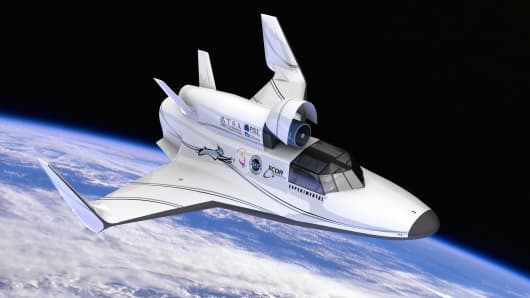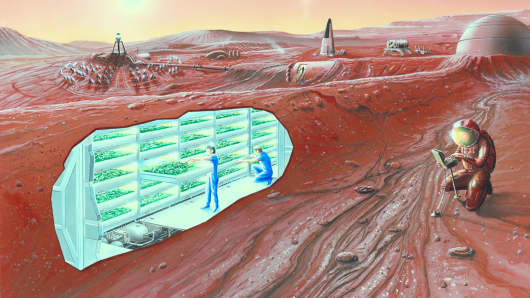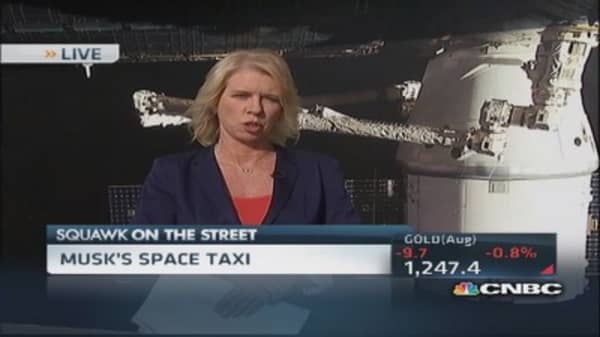More than three decades after the launch of the first space shuttle mission (and three years after the last one), investment in new human spaceflight systems is back with an intensity the aerospace industry hasn't seen since the heady days of the Space Race.
In the first half of this year, Elon Musk's Hawthorne, California-based SpaceX unveiled both an experimental reusable rocket stage and a new crew vehicle for carrying humans into orbit. By year's end, NASA will select a new crew vehicle from four commercial options, and its next-generation interplanetary crew vehicle, under development by Lockheed Martin, will begin flight tests.
Next year Mojave, California-based XCOR Aerospace will begin flying its two-seat suborbital Lynx spaceplane. In 2017, Sierra Nevada Corp. plans to send its seven-seat Dream Chaser spacecraft into orbit, while Boeing will launch the most powerful space rocket ever built—the one that will launch NASA/Lockheed's Orion and crew to an undetermined destination beyond orbit in 2021.
This current generation of spacecraft and launch vehicles under construction at private spaceflight ventures like SpaceX, Sierra Nevada, Orbital Sciences, Lockheed Martin Space Systems, Boeing Commercial Airplanes, Virgin Galactic, XCOR and Blue Origin represents not only a renewed interest in putting humans into space but new opportunities made possible by expanding markets in low Earth orbit (LEO) and, at some point in the next few decades, economic opportunities at destinations beyond.
Read MoreAmerica's weapon in the US-Russia space war
Improving economics is spurring the trend. "Up until this point, space transportation has been an exclusively money-losing proposition, and when things lose money, you don't do a lot of them," said Jeff Greason, founder and CEO of private space company XCOR. As he explained, technical progress will accelerate as investors get better returns on their investments.
With launch costs already decreasing and new destinations and revenue streams emerging in orbit, that is already happening. The industry is closer than ever to tipping over into profitability.
New destinations, new markets
According to Christopher Ferguson, former NASA shuttle commander and director of crew and mission systems for Boeing's commercial crew program, the business case for human space travel isn't so much about how you get there as it is about where you're going and how much it costs to get there.
"This really depends on what the destination is for low Earth orbit and how viable that destination is as a place for leisure or to conduct business," Ferguson said.
Those destinations are emerging. Though the International Space Station (ISS) currently serves as the only permanently manned outpost in space, Las Vegas-based Bigelow Aerospace is testing inflatable space habitats in orbit that it hopes to develop into a series of commercial space stations, serving as either scientific outposts that could be leased by government agencies or "space hotels" that would allow space tourists to spend extended periods in orbit. These stations would require regular resupply and the shuttling of researchers and tourists to and from orbit—services that could be supplied not by NASA or another space agency but by private space-transportation companies.
"There's a revolution happening in the ownership," said Mark Sirangelo, head of Sierra Nevada's space systems unit. "Everything else before this point was owned by the government. In this case, it's being owned by industry, built by industry. That's a fundamental change."
Read More2039: An investment space odyssey
Meanwhile, the cost per space launch is also undergoing fundamental change, thanks to a range of technological developments within the private spaceflight industry. SpaceX has famously shaken up the space launch industry by undercutting its competitors on launch price, in some cases by as much as half.
Other spaceflight companies, including Boeing Commercial Airplanes, Sierra Nevada and Jeff Bezos' Blue Origin, are variously developing new spacecraft designed to carry humans into orbital space as part of NASA's Commercial Crew Program (CCP). In addition, these companies are developing potentially less-expensive launch vehicles to get them there. (In the next few weeks, NASA will select one of four spacecraft under consideration to be its new workhorse for servicing the ISS, leaving three spacecraft in need of a new customer.)
The current high cost of human space transportation is largely tied up in rocket stages that are destroyed after a single use. There are two ways to go about solving this problem, XCOR's Greason said. The first: Recover, refurbish, and reuse rocket stages (SpaceX has developed and tested reusable rocket stages, and other companies, like Blue Origin, have patented related technologies). SpaceX CEO Elon Musk has predicted that if his company can make rocket reusability a reality, it could lower launch costs via its Falcon 9 rocket—currently advertised at $61.2 million—by an order of magnitude.
The other path to reusability is single-stage systems: those that go to space and back all in one piece without shedding rocket motors and fuel tanks along the way, allowing them to be reused over and over again. XCOR is pursuing the latter paradigm with its winged rocket-powered Lynx, a reusable space vehicle that will take off from a conventional runway and blast into suborbital space (roughly 330,000 feet, or 63 miles) powered by an onboard rocket motor before flying back to Earth and landing on a conventional runway.
It's here that the future of regular human space travel may have the most room to run. Concepts for wholly new hybrid rocket/air-breathing engine technologies, like those pioneered by U.K.-based Reaction Engines for its still highly conceptual Skylon space vehicle, could in the next decade materialize in runway-to-runway spaceplanes that can go to space and back relatively cheaply and with very fast turnaround between flights—something like a Boeing 777 for orbital destinations.
Both single-stage spaceplanes and reusable rocket stages have their merits, Greason said, and there's no obvious reason that one method might have an economic advantage over the other. What is obvious is that reusability will be the idea that drives space-transportation designs in the decades ahead. By the end of the next decade, neither spacecraft that take off and land from a runway like a conventional jet airliner nor reusable rockets will be outside the realm of possibility, and either could change the calculus of human space travel.
"The ability to get to orbit less expensively and in a more rapid nature could make a big dent in our ability to live and work in space," Sierra Nevada's Sirangelo said. "If we could solve the problem of getting to space more effectively than we do now, I think we would find ourselves doing more interesting, potentially game-changing things in low Earth orbit."
Those game-changing things aren't limited to science experiments and orbiting tourism hubs. With a more established presence in orbit, companies and space agencies will begin to explore experimental technologies, like in-orbit manufacturing.
Read MoreThe billionaire's race to harness the moon's resources
One of the big limiting factors in plaguing future space missions is lifting off from Earth with all the supplies, fuel, spacecraft and equipment humans would need to establish a permanent lunar base or field a Mars mission. Manufacturing facilities in orbit would allow components and raw materials to be shipped into orbit piecemeal and assembled into the means for future missions to points beyond, Sirangelo said. "It's far easier to launch something from orbit than it is to launch it from the ground."
The space beyond
If the next decade of human space transportation is about private companies finding and developing cheaper and more efficient ways into Earth orbit, the decade following will be all about space agencies learning how to operate farther and farther from home, with an eventual eye to orbiting and eventually landing humans on Mars in the mid-2030s (per NASA's timeline).
Solutions to the technical challenges in doing so are already in the works, largely thanks to research conducted over more than a decade of continuously inhabiting the ISS, said Jason Crusan, director of advanced exploration systems within NASA's Human Exploration and Operations Mission Directorate. "We have used the LEO environment to learn quite a lot about the human as a system, and we've developed a lot of countermeasures for those effects over time."
Among the challenges NASA faces in taking humans deeper into space:
- Developing a completely closed-loop system for water supplies that recycles every drop of sweat, urine, condensation and wastewater into drinkable water for the crew.
- Space agriculture systems that allow for the growing of food in space.
- Air-recycling systems that can reliably scrub carbon dioxide and provide enough oxygen for humans during a long-duration spaceflight (the flight to Mars takes nine months).
- Radiation shielding to minimize dangerous solar and cosmic radiation that are far less of an issue within the protective boundaries of Earth's magnetic field.
Aboard the ISS, things like a closed-loop water-recycling system and reliable space-borne agriculture are already close to reality, Crusan said.
NASA's Orion spacecraft offers a glimpse into this future. Though its gumdrop shape and exterior look evokes memory of the Apollo spacecraft of four decades ago, Orion's developers at Lockheed Martin Space Systems have built all kinds of next-generation technologies into the spacecraft, including enhanced radiation shielding and a new generation of carbon-scrubbing technology to maintain the crew's breathable environment.
Slated for a first crewed mission in 2021, it is expected to serve as NASA's deep-space exploratory spacecraft for the next decade, potentially carrying astronauts to the moon, nearby asteroids and even Mars or one of its moons in the 2030s. As it happens, the next two decades of deep-space travel is already shaping up in a hangar in Florida.
That doesn't mean there won't be new developments, Boeing's Ferguson said, but that it's possible to get a pretty good look at the future of human space transportation—even space transportation to places far beyond what technology is currently capable of—by looking at the various technologies already under development today and imagining how they'll complement each other in the future.
"I don't think you're going to see anything out of Star Wars," he said of future manned missions to deep-space destinations. "You'll see something like Orion, but something like Orion coupled up with an inflatable space habitat."
From a technical standpoint, there's little holding NASA and private industry back from an era in which humans move freely between Earth and orbit or orbit and points beyond, Greason said. Industry is ready, and the scientific community is eager. The next era of human space transportation can really start as soon as humans decide they want it to.
"If the American taxpayer wants to send a government-backed, manned mission to the moon, or to an asteroid, or to Mars, we can do it anytime we want to do it, and it shouldn't have to take 20 years," Greason said. "I'm in the private space business because I don't feel like waiting 20 years for something to happen. So I'm focused on what can we start doing right now."
—By Clay Dillow, special to CNBC.com









































